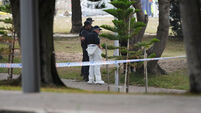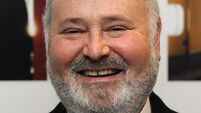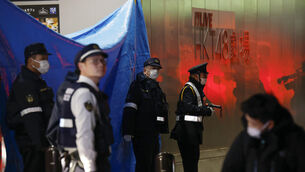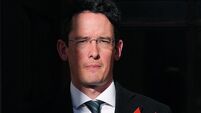Search for survivors winds down amid battle to resettle homeless
The seaport in Port-au-Prince had been repaired enough to reopen for limited aid shipments, and a Dutch naval vessel was unloading pallets of water, juice and shelf-stable milk onto trucks at the pier.
Aid was more plentiful but still inadequate to feed and shelter the masses left homeless and injured by the 7.0 magnitude quake that rocked Haiti’s capital, Port-au-Prince, on January 12 and killed as many as 200,000 people.
A Florida search-and-rescue team left Haiti yesterday and it was reported that teams from Belgium, Luxembourg and Britain did as well.
Teams from Brazil, the United States and Chile were still working with sniffer dogs at the collapsed Montana Hotel in Port-au-Prince, where a whiteboard listed the names of 10 people found dead and 20 more still missing inside. Crews had treaded gingerly, shifting rubble by hand, but were switching to heavy machinery to dig up the bulk of the hotel.
“We’re looking for people alive or dead,” said Chilean Army Major Rodrigo Vasquez. “As well as being hopeful you have to be realistic and after nine days, reality says it is more difficult to find people alive but it’s not impossible.”
The USNS Comfort arrived in Haitian waters with its hospital and advanced surgical units. Around 12,000 US military personnel are in Haiti and on ships offshore.
Sensitive to appearances the United States was taking too forceful a role, President Barack Obama said the White House was being “very careful” to work with the Haitian government and the United Nations.
The UN is adding 2,000 troops and 1,500 police to the 9,000-member peacekeeping mission in Haiti.
Between 1 million and 1.5 million Haitians were left homeless by the earthquake and Interior Minister Paul Antoine Bien-Aime said some 400,000 of them would be moved to new villages to be set up outside the ravaged capital.
In the first wave, the government would move 100,000 refugees to tent villages of 10,000 each near the town of Croix Des Bouquets north of the capital, he said.
Brazilian UN peacekeepers were already levelling land in Croix des Bouquets to set up a transitional tent camp at a site where the Inter-American Development Bank planned to help build permanent houses for 30,000 people.
The plan would let displaced Haitians help build their own new homes under a food-for-work scheme, allowing them to stay close to the area where they had made a living.
Many for now were jammed into haphazard, open-air camps with no latrines, sleeping outdoors because their homes were destroyed or out of fear that aftershocks would bring down more buildings.
Banks were to reopen yesterday in the provinces and today in Port-au-Prince, giving most Haitians their first access to cash since the quake hit, said Commerce Minister Josseline Colimon Fethiere. Some bank branches were demolished in the earthquake but the banks planned to share customers and to stay open on Sunday, she said.
The Haitian government and its international partners turned their focus to long-term rebuilding of a nation that was poor and chaotic even before the earthquake struck.
“Are we satisfied with the job we are doing? Definitely not,” said Jon Andrus, deputy director of the Pan-American Health Organisation.
“But progress is being made. Think of what we started with when the world came crashing down on Haiti. No roads, only rubble and dead bodies. No communication, only death and despair.”
Most of the basics of city life were still missing or barely functional in Port-au-Prince. Hospitals were overwhelmed and doctors lacked anaesthesia, forcing them to operate on wide-awake patients with only local painkillers.
Doctors Without Borders said there were 10 to 12-day backlogs of patients at some of its surgical sites and they were seeing infections of untreated wounds.
“Some victims are already dying of sepsis,” the group said.
Aid groups brought in mobile kitchens and bakeries but struggled to feed the hungry. The World Food Programme estimated there were 200 homeless encampments in Port-au-Prince alone and urged the government to begin consolidating them to streamline aid distribution.
“We will probably need to feed between one and two million but it depends on the rate at which people leave the city,” said Thiry Benoit, WFP’s deputy country representative in Haiti.
The city’s water system was only partially functional but tanker trucks began to deliver water to makeshift camps.
The Geneva-based International Organisation for Migration (IOM), distributed tents, blankets and plastic sheeting provided by Japan and Turkey, but warned that more permanent shelter would soon be needed.
Violence and looting has subsided as US troops provided security for water and food distribution and thousands of displaced Haitians heeded the government’s advice to seek shelter outside Port-au-Prince.
Meanwhile rescuers pulled two more people from the rubble, more than a week after a massive 7.0-magnitude quake.
Two children were pulled from collapsed buildings in Port-au-Prince on Wednesday.
A five-year-old boy was found in the wreckage of his home while neighbours dragged out an 11-year-old girl in another part of the city.
Mendji Bahina Sanon, 11, was taken to a French-run field hospital in the capital, clearly struggling with the nightmare as she cried, “don’t leave me, Mama”.
Makeshift hospitals struggled to treat the tens of thousands of injured.
“We carried out 30 operations on Tuesday. In the previous six days we have cared for more than 1,000 Haitians,” said French doctor Thierry Allafort Duverger at a clinic in the upscale suburb of Petionville that normally specialises in plastic surgery, but is now one of 30 special hospitals set up to care for earthquake victims.













